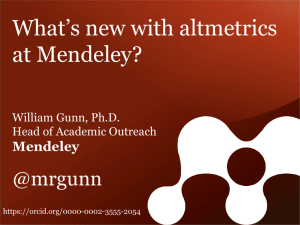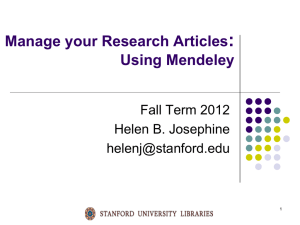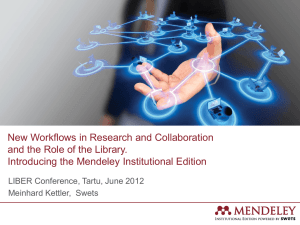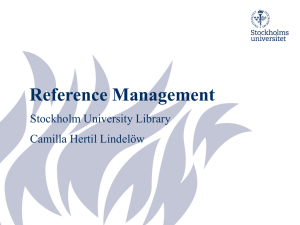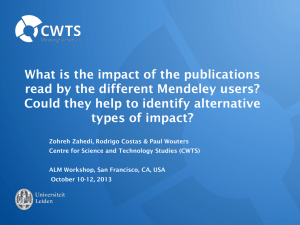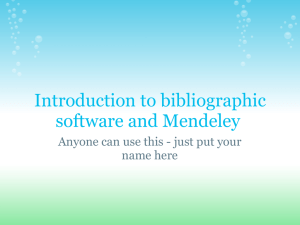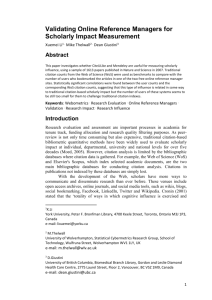Measuring Non-standard research impact?
advertisement
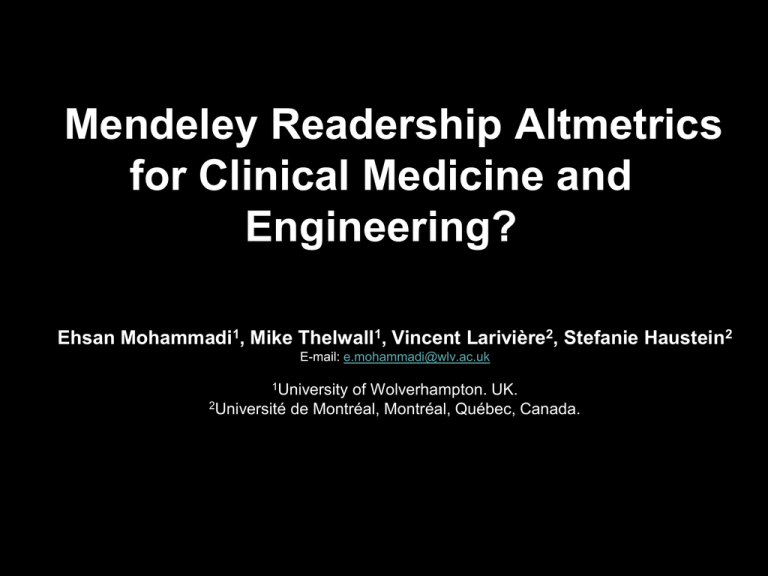
Mendeley Readership Altmetrics for Clinical Medicine and Engineering? Ehsan Mohammadi1, Mike Thelwall1, Vincent Larivière2, Stefanie Haustein2 E-mail: e.mohammadi@wlv.ac.uk 1University 2Université of Wolverhampton. UK. de Montréal, Montréal, Québec, Canada. Citation is incomplete • Limited • More to authors’ perspectives.(Schloegl & Stock, 2004). • appropriate for theoretical publications. 3-5 years times are needed for receiving citation • Citation indicators are not able to give the full picture of research impact Usage Metrics are tasteful but.. • They mainly employed local usage data. • Downloaders are unknown. • Data aggregation is not easy. Altmetrics as a solution? Altmetrics is a new movement which tries to find complementary measures for traditional metrics based on scholars’ activities in social web platforms (Priem, Taraborelli, Groth, & Neylon, 2011). Data collection is faster. Data is more accessible. Data coverage is global. Diversity in data type (not limited to authors) Why Mendeley? • Massive users • Diversity of users • Huge size of database • Open API • Global coverage Research Question • • What proportion of Clinical Medicine and Engineering articles are covered by Mendeley database? Are there significant, substantial and positive correlations between Mendeley readership counts and citation measures in Clinical Medicine and Engineering specialties? Method • Montreal university’s in-house version of the Thomson-ISI databases were used for data collection. • Based on NSF classification, the most productive specialities of engineering and clinical medicine were selected • All bibliographic information + citation data of the journal articles of the year 2008 were downloaded. • 145,536 for clinical medicine and 109,390 for engineering. • Statistics data related to Mendeley readership for the WoS articles were extracted using the Mendeley API. • The WoS data set and Mendeley readership data were matched and duplications were removed. • Spearman correlation tests were applied to the ISI citations and Mendeley readership counts. % of WoS articles fro 2008 from Clinical Medicine and Engineering specialities in Mendeley 90 80 70 60 50 40 30 20 10 0 Unique WoS articles covered by Mendeley Duplicated records in Mendeley catalogue Articles with readership statistics in Mendeley Findings • • • We considered the coverage in Mendeley for different specialties based on the available unique records in Mendeley catalogue. Clinical Medicine articles had the higher coverage (71.6%) in comparison to Engineering and Technology (33.7%) papers. 1.5% of the overall founded records of both Engineering and Clinical Medicine were subjected to duplication. Spearman correlations between WoS citations and Mendeley readership counts (non-zero only) for 2008 Clinical Medicine and engineering articles 0.8 0.7 0.6 0.5 0.4 0.3 0.2 0.1 0 Findings • • • • There is a significant correlation between Mendeley readership and citation counts in all the investigated specialities. The correlation for clinical medicine overall (r=.561) is higher than for engineering (r=.501). Cancer (r=.604) and Materials Science (r=.682) had the highest correlations among clinical medicine and engineering specialties. Surgery (r=.451) and Computers (r=.414) had the lowest correlations among Clinical Medicine and Engineering and Technology specialties. Comparison of citation and Mendeley readership median for 2008 Clinical Medicine and engineering articles WoS citation median Mendeley readership median Findings • • The median Mendeley readership counts were higher than the median citation counts for mechanical and computer engineering papers. This is due to that mechanical and computer engineering papers were read more and citied less. Limitations • • Readership is limited to the individuals who choose Mendeley for their reference manager. Our studied sample is restricted to journal articles while conference papers are important document types in engineering disciplines. Conclusions • • • In almost all disciplines, the correlation is not strong enough to conclude that Mendeley readership and citation counts measure the same aspect of research impact. A likely explanation is that Mendeley captures broader scholarly activities from a variety of readers’ perspectives in comparison to citation counts. Hence, Mendeley readership data could be a useful supplementary measure to remedy some limitations of citation analysis for some applied specialities.
